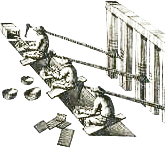gipuzkoakultura.net




Gipuzkoa's important metallurgical industry undoubtedly lay behind the genesis of a large number of specialist trades, involving processing and manufacture of pieces in iron or iron alloy, which were one of the foundations of the province's subsequent development. Any treatise on iron-working in Gipuzkoa must include its important arms industry which manufactured
defensive and offensive weapons. The abundance and quality of the raw material-obtained in the province itself-and local skill and experience in handling it, were to lead to the progressive development of the industry and its fame throughout Spain. The proliferation of workshops and craftsmen earned the area the first large crown contracts, and one result was the emergence of the Reales Fábricas de Armas, or Royal Arms Commissioners.
Gipuzkoan workshops and guilds and especially those in the lower Deba valley received the first royal contracts in the fifteenth century. The growing demand from the Spanish crown, keen to maintain and defend its great European and overseas empire, required regulated organisation of its contract system, and the result was the establishment of the Royal Commissioners' Offices. These were not specific places or buildings, but rather a hierarchical and specialised guild organisation developed between the sixteenth and eighteenth centuries.
There were already historical precedents in the manufacture of conventional "bladed" weapons, which overlapped with the manufacture of firearms. Pikes, shields, lances, breastplates, helmets, sallets and other pieces of armour were manufactured throughout the province at small forges, alongside swords, cutlery, scissors, etc. The important role played by the Deba valley in this activity was only partially overshadowed by the Royal Weapons Commissioners of Tolosa, created in 1616, following closure of the one in Eugi (Navarra), which concentrated the work of a large number of craftsmen from the surrounding area, who thus gained a fixed contract with the state for their products. The Deba area nonetheless maintained an effective presence in the field of traditional weapons, and continued to make morrion helmets, light armour, studs, bayonets, pikes, etc. They also made short and light arms, and in this field the work of the well-organised guild of cutlers of Bergara-which had its own bylaws as early as 1535-was particularly important.

The Reales Fábricas were organised on the basis of a system of asientos: direct supply contracts with the monarch's representatives, which set out the type, number and characteristics of the weapons to be made. The crown undertook to ensure the supply of raw materials, thus controlling the entire process, and it had a set of overseers and examiners who tested the manufactured components and, when they had passed them, took charge of storing them until they were despatched. The headquarters for these operations was in Placencia-Soraluze, where the testing-houses and stores-known as Errege-etxe-were located.
The guild deputies placed the orders and distributed manufacture among the craftsmen, regulating delivery times, quality and payments. The process of manufacturing firearms did not all take place in the one workshop. Each piece involved work by four different guilds, each of which was represented in nearly all the municipalities of the region and surrounding areas (such as the Upper Ibaizabal valley in Bizkaia). Their functions were clearly defined: the barrel-makers were in charge of making the barrel of the gun; the cock-makers made the "cock", the mechanism that allowed the gun to be fired, the riggers assembled and fitted the parts and the case-makers gave the gun its final finish.
The output of the Royal Commissioners varied: after the glory days of the sixteenth century, in the seventeenth they were plunged into a deep crisis which would only end in the eighteenth century, with a new boom which was in turn brought to an end by the destruction of the War of the Convention. With the disappearance of the system of Reales Factorías, many skilled workers moved to other areas (Zaragoza, Trubia, Seville, etc.) while others strove ceaselessly to try to reactivate the system. Sorlauze's formerly predominant position was challenged by Eibar, where throughout the nineteenth century local artisan entrepreneurs set the way for the development of modern industry.

Their work was regulated by the rules and customs of the trade guild, and workers were divided into masters, skilled workmen and apprentices. The former normally owned or rented the workshop and the success of the business depended on his knowledge and skill. In order to carry out the work he would have a group of skilled workers with proven experience, who earned a fixed wage and an additional "placeraje", a kind of productivity bonus. The bottom rung in the ladder was occupied by the apprentices, who served their masters for a minimum of three years, in exchange for food, lodging and clothes. After their apprenticeship, and an exam organised by the guild or master, they were eligible for the category of skilled worker and could hire out their labour for a wage.